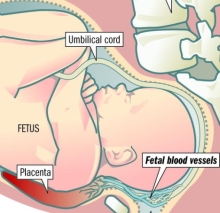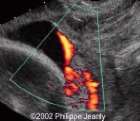Well I now know what the word phallumegaly means – click here to know 🙂 LOL…
I also didn’t know that Barney Stinson made it onto Wikipedia under the guise of Lorenzo von Matterhorn LMAO. Click here for link
I want to raise awareness on the subject of Vasa Previa as I feel its not checked up on enough prenatally because it is rare. If Vasa previa is not picked up prenatally – it can lead to the most horrendous brain damage and poor outcome of the child or even stillbirth. This is what it looks like on the inside.

2 years ago I asked the hospital where my daughter died to introduce this pre-natal test to stop any parents from having to go through the misery and agony of neo-natal death or stillbirth. They told me they would consider introducing the test and thought it was a good idea. Sadly these were just words. 2 years later – I have seen the same hospital still has not implemented the ROUTINE pre-natal test. So I am writing a blog post to tell others just to check out for it if they are pregnant. It bothers me. I told the hospital at the time, if you have this test you could maybe solve a lot of the neo-natal and stillbirths – might even cut this ratio in half. They did not disagree with me but yet it upsets me that due to a possible baby boom – this condition can go so easily undetected.
Hospitals at the best of times can not check for it due to patient numbers or short staffing but I feel all women should check for it regardless. Medical research has always been an interest of mine. I hope that stem cell work will be developed more because currently babies and adults – once they have a brain injury – there is not much that can be done. My theory is that stem cells can be harvested from a healthy placenta but not enough about the topic is currently known. Perhaps there is an ethical issue. I do not know. However, I do not feel that the stem cells of another embryo will work and that it is imperative that the stem cells of the baby with the brain damage comes from the placenta it nurtured off in order to avoid infection. If the scientists one day discover this, please let me know.
It has taken me two years to write this post up on the internet but at least I finally do now. Its hard to write this but if it helps someone out there then I guess that is good. The pain of child death never fully goes away even after some time has considerably passed but I feel if I can let others know NOW maybe this will save some children out there. My experience has been traumatic to say the least. I remember been told I was ‘over-reacting’ to my sixth sense. Then after she passed away I was told by doctors, you were right – sorry.. we should have taken you more seriously. So now here I am wanting to make you guys who read my blog aware. I had been so careful -which is what made it feel so unfair – had done all the checks – I just had never pencilled in this condition. Currently tests can not be carried out pre-natally on placentas. I hope one day that this changes.
What happened to me?
I don’t want to scare women out there but I suffered vasa previa during pregnancy which sadly resulted in the death of my daughter – Jasmine – 2 years ago. I am writing this post for women out there who may NOT be aware of this condition. There is currently so little information on the internet and in the bookshops about this. I guess because the condition is SO rare in itself. Vasa praevia occurs in 1:2500 births – approximately 380 babies per year in the UK. If you have had this condition once, you can have it again. They say its rare you can get it twice on a subsequent pregnancy but it can happen easily again in my opinion.
What is vasa previa?
Through much research that I have conducted since the tragedy, I found this video and so uploaded it onto youtube as I notice there is practically nothing in terms of information on youtube when you search for vasa previa. I guess well done to these parents – how brave of them to speak out about it when it is the most heartbreaking condition anyone can ever endure in their life-time.
click here for link that describes this condition in more medical detail – go to FAQ section.
Generically speaking,
* Vasa praevia occurs when one or more of the baby’s placental or umbilical blood vessels cross the entrance to the birth canal beneath the baby.
* When the cervix dilates or the membranes rupture, the unprotected vessels can tear, causing rapid fetal haemorrhage.
* The fetal mortality rate is estimated to be as high as 95% if the condition is not prenatally diagnosed.
* In cases diagnosed prenatally the survival rate (absent any other congenital defect) is 100%.
(as long as you get the baby sectioned out of you at 35 weeks – BEFORE the waters go)
* Studies show that there has never been an infant death following antenatal diagnosis of vasa praevia
(providing your waters have not gone or the membranes have not ruptured prior to delivery)
* At present there is no recognised protocol for antenatal diagnosis of vasa praevia in the UK or Ireland.
(so ask for a color doppler test to be done at 18 wks if you are suspicious or if you have had painless brown bleeding accompanied with a low-lying placenta – Brown blood is old blood that is usually what I believe a signal from the cervix – if you have bright red blood then you have a problem – it is knowing the difference that I feel is critical)
How can you know for sure if you have vasa previa?
Usually you get a low-lying placenta in the second trimester – now this can move up by the third trimester BUT its important to get a test called a color doppler done at 18 wks – in this test you can see if the membranes and waters are crossing the cervix. If you have vasa previa – this is what it will look like on a color doppler.

Risk Factors:
Low-lying placenta or placenta previa (I had this)
Bilobed or succenturiate-lobed placenta (I had this)
Velamentous insertion of the cord (I had this!)
In-vitro fertilization pregnancies (didn’t have this)
Multiple pregnancies (she had a twin placenta! one twin never developed in utero)
History of uterine surgery or D&C (yes)
Painless bleeding (had this – was a brown-like discharge before a low lying placenta)
Diagnostic Testing: (sadly no as was told not to over-react)
Transvaginal color Doppler ultrasound for women with above risk factors (at 18 wks)
Document normal central umbilical cord placental insertion during all routine obstetrical ultrasounds
Management: (this can be seen on the color doppler test)
What can you do to avoid tragedy??
Pelvic rest (bed rest etc)
Hospitalization in the 3rd trimester
Delivery by C-section at 35 weeks (before waters and membranes go)
Immediate blood transfusion and aggressive resuscitation of the infant in the event of a rupture
To any women out there. Don’t worry. Education is key. Now that you have read all this at least you can rest assured that you are more prepared. Good luck with your impending births – thanks to read my story. I feel this condition is not taken seriously enough hence making it onto my blog.
HELPFUL LINK: click here http://www.vasapraevia.co.uk/